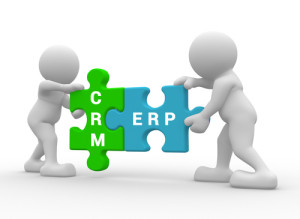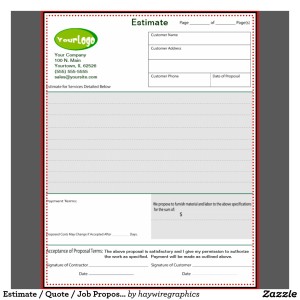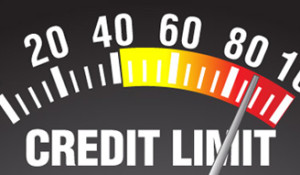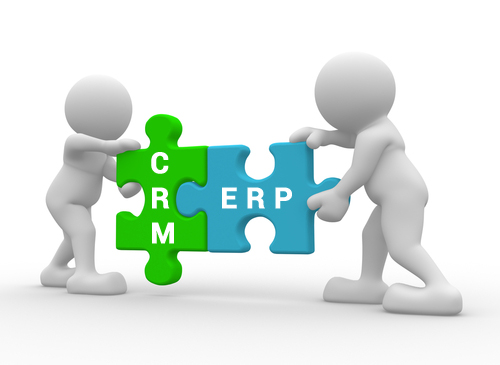Does your ERP talk to your CRM?
First, ERP stands for enterprise resource planning. It can be used to refer to accounting systems and also solutions that manage inventory, product pricing and shipping. Popular ERPs include Sage 50 (formerly Peachtree Accounting), Microsoft NAV, Epicor Vista and Viewpoint Vista. Of course, many small businesses use QuickBooks as their ERP. Oh, and by the way, CRM stands for customer relationship management. CRMs like Salesforce.com and SugarCRM purport to easily integrate with these and other ERPs.
So why should CRM and ERP talk to each other?
In most businesses, new customer orders require both systems. At a minimum, there will be double entry of information in both systems. Often, things are more complicated. Integrating your ERP with your CRM can more efficiently handle new customer orders, reduce data entry errors and greatly enhance tracking of quotes, orders, sales and inventory.
Quotes, Estimates and Proposals
If you’re providing written pricing to customers, then you know that there is a lot of time spent preparing each one. You want it to look good, be clear  and understandable and accurate.
and understandable and accurate.
Even in a business with a relatively simple list of products or services, automating the process of providing a quote or proposal can eliminate mistakes by sales reps and save time. In today’s world, if it takes your team longer to provide price to a customer than your competition, it could cost you sales.
In a business with a complex list of products and services where availability of certain inventory impacts what’s quoted to the customer, salespeople can’t provide a proposal to the customer without checking with someone that has access to the ERP, to check availability, current pricing, etc. If the CRM is automatically pulling in up to date inventory, parts numbers, pricing, etc., then the sales rep can provide quotes to customers in real time!
Pipeline Management and Forecasting
One of the great promises of CRM is to provide reporting and analytics on the sales pipeline and the ability to accurately forecast revenue. Of course, this relies on salespeople updating the CRM with each quote they provide to customers and updating status as things change. Unfortunately, most organizations struggle to consistently update proposals and pipeline information. Salespeople just forget to put the proposal in the system or to update its status.
The good news is that if the CRM and ERP and integrated, then the CRM becomes the entry point for all estimates, proposals and quotes. That means everything gets put into the CRM from the beginning and any changes are made there too. This also enables a very powerful type of reporting! If your report of quotes delivered to customers comes from the CRM and your report of sales or orders actually closed comes from an ERP that is not integrated with the CRM, then you’re forced to reconcile quotes to orders in order to get a picture of the average number quotes it takes to get an order. But, if the CRM and ERP are talking to each other, then the reconciliation is taken care of automatically and you can slice and dice your pipeline by salesperson, product, price and lots more.
Order Status and History
If your ERP is sharing customer order information with the CRM, the the salesperson’s life gets a LOT easier. How many times is a salesperson asked by the customer about the latest order? “When will that ship?”, “What’s our price on the ABC part?”, etc.
Imagine if your salesperson had instant access to that information! Plus, having access to this information allows the salesperson to identify opportunities they may be missing. After all, how do they know that a certain customer had been ordering 3 units of this or that every month and hasn’t ordered any for a month or two?
Account Balance and Credit Limit
When the customer calls the salesperson and places another order, if the salesperson has no idea what the customer’s credit limit is or if they’re close to that limit, how many different people on your staff and the customer’s team waste time figuring it out?
What if the salesperson could update the customer immediately on that status: “Thanks for your order Bob! Looks like your credit limit is $10,000 and this order will put you over that limit. Would you like to make a payment now so I can process this new order for you?”
Prioritizing Customers
Do your sales reps have a sort of farming mentality to managing their accounts? Do they go through a process of calling each key customer once per month or quarter? The problem with this approach is that customers don’t do business on our schedule. Their needs change rapidly.
With a CRM that talks to your ERP, salespeople can be focused on customers that haven’t ordered in quite a while or customers that just placed an order. Salespeople can be tasked to follow up just after the customer placed an order for parts to talk about new models.
The CRM can leverage ERP information to focus salespeople AND marketing messages in the right places at the right time.
Considerations
Syncing Companies and Contacts: You’ll need a way to keep the accounts and contacts sync’d up so that when the sales rep changes an email address or a contact moves from one company to another, things don’t start ending up in the wrong place and your don’t end up with duplicate records. Most systems use an account number or other unique identifier to keep this well in hand.
Product list changes: How often will your list of available products change? Is available inventory a factor in providing quotes to customers? If so, then you’ll need to be sure that the ERP is updating the CRM with the latest product info regularly.
Prices: Do certain customers have special pricing on certain items? Then the ERP and CRM will need to stay in sync on that information. The salesperson can create a lot of problems by quoting the wrong price.
Many CRMs like Salesforce.com, SugarCRM and others have “pre-built” add-ons that enable communication between certain ERP systems. However, be aware that some are only available with higher end editions of the CRM so, an upgrade may be required.
Another consideration is support. As above, integrating ERPs like Sage 50, Microsoft NAV, Vista and others can involve using a 3rd party add-on not developed or supported by either the CRM or ERP company. So, when it breaks, who do you call? Do you have a support contract with them? How quickly will they respond? Will they ultimately just direct you to the other vendor?
Also, “pre-built” ERP to CRM connections are just that, pre-built, one-sized-fits-all solutions. Be sure you dig deeply into the limitations to the capabilities. Often, the most valuable piece of information to have in your CRM is that highly unique piece of data that only matters to your business.
Click here to see how SalesNexus enables integration with your ERP or Accounting software unique to your way of doing business.

